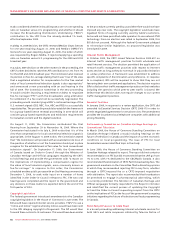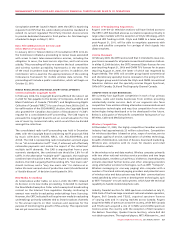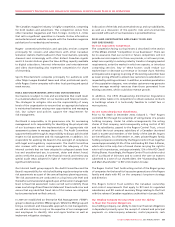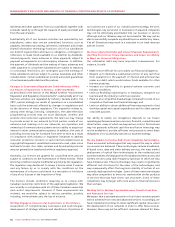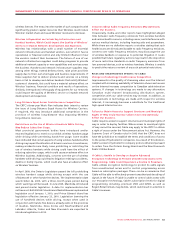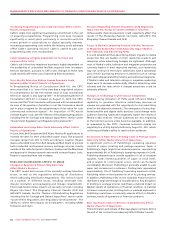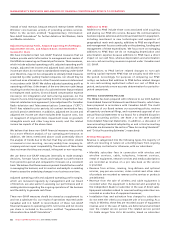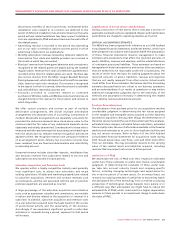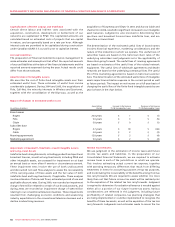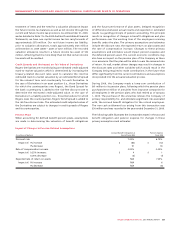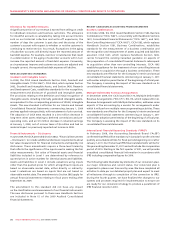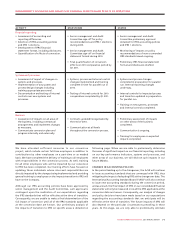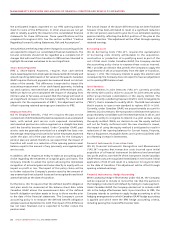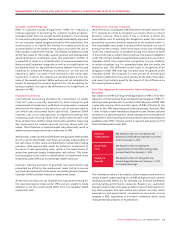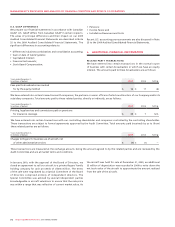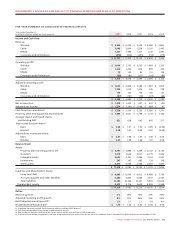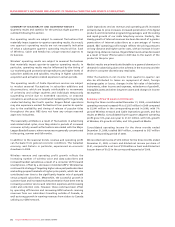Rogers 2009 Annual Report Download - page 62
Download and view the complete annual report
Please find page 62 of the 2009 Rogers annual report below. You can navigate through the pages in the report by either clicking on the pages listed below, or by using the keyword search tool below to find specific information within the annual report.
66 ROGERS COMMUNICATIONS INC. 2009 ANNUAL REPORT
MANAGEMENT’S DISCUSSION AND ANALYSIS OF FINANCIAL CONDITION AND RESULTS OF OPERATIONS
instead of total revenue, because network revenue better reflects
Wireless’ core business activity of providing wireless services.
Refer to the section entitled “Supplementary Information:
Non-GAAP Calculations” for further details on this Wireless, Cable
and Media calculation.
Adjusted Operating Profit, Adjusted Operating Profit Margin,
Adjusted Net Income, and Adjusted Basic and Diluted Net
Income Per Share
We have included certain non-GAAP financial measures that we
believe provide useful information to management and readers of
this MD&A in measuring our financial performance. These measures,
which include adjusted operating profit, adjusted operating profit
margin, adjusted net income and adjusted basic and diluted net
income per share, do not have a standardized meaning under GAAP
and, therefore, may not be comparable to similarly titled measures
presented by other publicly traded companies, nor should they be
construed as an alternative to other financial measures determined
in accordance with GAAP. We define adjusted operating profit as
operating profit less: (i) the impact of the one-time non-cash charge
resulting from the introduction of a cash settlement feature related
to employee stock options; (ii) stock-based compensation expense
(recovery); (iii) integration and restructuring expenses; (iv) the
impact of a one-time charge resulting from the renegotiation of an
Internet-related services agreement; (v) an adjustment for Canadian
Radio-television and Telecommunications Commission (“CRTC”)
Part II fees related to prior periods; (vi) contract termination fees;
and (vii) pension settlement. In addition, adjusted net income and
adjusted net income per share excludes debt issuance costs, loss
on repayment of long-term debt, impairment losses on goodwill,
intangible assets and other long-term assets, and the related
income tax impacts of the above items.
We believe that these non-GAAP financial measures may provide
for a more effective analysis of our operating performance. In
addition, the items mentioned above could potentially distort
the analysis of trends due to the fact that they are either volatile
or unusual or non-recurring, can vary widely from company-to-
company and can impair comparability. The exclusion of these items
does not mean that they are unusual, infrequent or non-recurring.
We use these non-GAAP measures internally to make strategic
decisions, forecast future results and evaluate our performance
from period-to-period and compared to forecasts on a consistent
basis. We believe that these measures present trends that are useful
in managing the business, and to investors and analysts in enabling
them to assess the underlying changes in our business over time.
Adjusted operating profit and adjusted operating profit margins,
which are reviewed regularly by management and our Board
of Directors, are also useful in assessing our performance and in
making decisions regarding the ongoing operations of the business
and the ability to generate cash flows.
These non-GAAP measures should be viewed as a supplement to,
and not a substitute for, our results of operations reported under
Canadian and U.S. GAAP. A reconciliation of these non-GAAP
financial measures to operating profit, net income and net income
per share is included in the section entitled “Supplementary
Information: Non-GAAP Calculations”.
Additions to PP&E
Additions to PP&E include those costs associated with acquiring
and placing our PP&E into service. Because the communications
business requires extensive and continual investment in equipment,
including investment in new technologies and expansion of
geographical reach and capacity, additions to PP&E are significant
and management focuses continually on the planning, funding and
management of these expenditures. We focus more on managing
additions to PP&E than we do on managing depreciation and
amortization expense because additions to PP&E have a direct
impact on our cash flow, whereas depreciation and amortization
are non-cash accounting measures required under Canadian and
U.S. GAAP.
The additions to PP&E before related changes to non-cash
working capital represent PP&E that we actually took title to in
the period. Accordingly, for purposes of comparing our PP&E
outlays, we believe that additions to PP&E before related changes
to non-cash working capital best reflect our cost of PP&E in a
period, and provide a more accurate determination for period-to-
period comparisons.
CRITICAL ACCOUNTING POLICIES
This MD&A has been prepared with reference to our 2009 Audited
Consolidated Financial Statements and Notes thereto, which have
been prepared in accordance with Canadian GAAP. The Audit
Committee of our Board reviews our accounting policies, reviews
all quarterly and annual filings, and recommends approval of our
annual financial statements to our Board. For a detailed discussion
of our accounting policies, see Note 2 to the 2009 Audited
Consolidated Financial Statements. In addition, a discussion of
new accounting standards adopted by us and critical accounting
estimates are discussed in the sections “New Accounting Standards”
and “Critical Accounting Estimates”, respectively.
Revenue Recognition
Revenue is categorized into the following types, the majority of
which are recurring in nature on a monthly basis from ongoing
relationships, contractual or otherwise, with our subscribers:
• Monthly subscriber fees in connection with wireless and
wireline services, cable, telephony, Internet ser vices,
rental of equipment, network services and media subscriptions
are recorded as revenue on a pro rata basis as the service
is provided;
• Revenue from airtime, roaming, long-distance and optional
services, pay-per-use services, video rentals and other sales
of products are recorded as revenue as the services or products
are delivered;
• Revenue from the sale of wireless and cable equipment is
recorded when the equipment is delivered and accepted by
the independent dealer or subscriber in the case of direct sales.
Equipment subsidies related to new and existing subscribers are
recorded as a reduction of equipment revenues;
• Installation fees and activation fees charged to subscribers
do not meet the criteria as a separate unit of accounting. As a
result, in Wireless, these fees are recorded as part of equipment
revenue and, in the case of Cable, are deferred and amortized
over the related service period. The related service period
for Cable ranges from 26 to 48 months, based on subscriber


